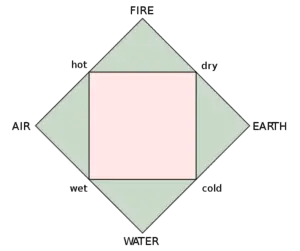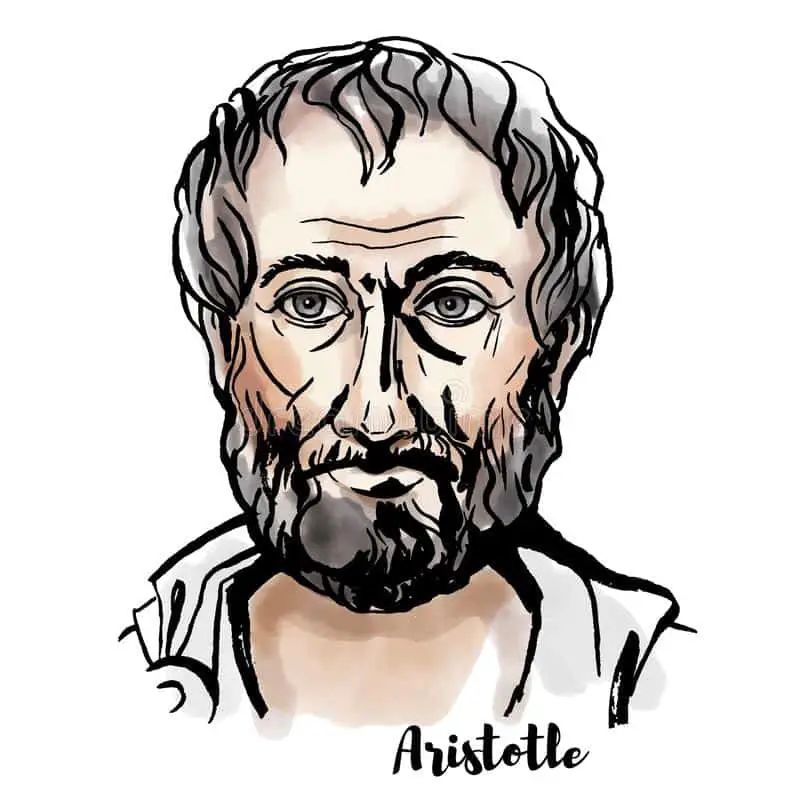In the history of the cosmos, so many cosmological theories have come into existence and later became obsolete. Similarly, so many more cosmological models of the universe will come too. One of them is the Aristotelian Universe i.e geocentric model of the universe.
In this article, I will give you a brief review of Aristotle’s model of the universe. Well, nowadays this cosmological model of the universe has become obsolete. Here is the list of things that I will be discussing in the Aristotelian Universe. So, sit tight, and enjoy the ride. And, let me know what you think about them in the comment section. Aristotelian Universe – Let’s Go Back In time…!!!
- Aristotelian Universe
- Division of Aristotelian Universe
- Classical elements of Aristotelian Universe
- Aristotle’s Theory Of Motion
- Aristotle’s Theory Of Gravity
- Death of Aristotelian Universe
Aristotelian Universe
In Aristotelian Universe, the earth is the center of the universe, and all the planets, stars, sun, and all heavenly bodies revolve around the earth. Aristotle believed that the earth is eternally unmoved and everything else revolves around it in concentric spheres.
Aristotle’s view of the universe was widely accepted from its inception until the emergence of the scientific revolution. Although, the Aristotelian principle was widely accepted by scientists and philosophers of his time. Yet, there were some who openly criticized Aristotle’s beliefs.
Aristarchus of Samos
One of the most repulsive critics of Aristotle’s model of the universe was Aristarchus of Samos. Maybe, because he had developed his own cosmological model of the universe. Well, if you don’t know, Aristarchus was the first person to present the heliocentric model of the universe. That’s why Nicolaus Copernicus himself credited his heliocentrism to Aristarchus of Samos.
Views of Aristarchus of Samos
Well, the original work of Aristarchus of Samos has been lost for centuries. But, some of his work references can be found in the writings of ancient physicists. A reference found in Archimedes’ Book The Sand Reckoner. YES, the Archimedes who gave us the principle of Buoyancy.
You are now aware that the “universe” is the name given by most astronomers to the sphere, the center of which is the center of the earth. While its radius is equal to straight line between center of the sun and center of the earth. This is the common account as you have heard from astronomers. But Aristarchus has brought out a book consisting of certain hypotheses, wherein it appears, as a consequence of the assumptions made, that the universe is many times greater than the “universe” just mentioned.
His hypotheses are that fixed stars and the sun remain unmoved. And that the earth revolves around the sun on the circumference of a circle, the sun lying in the middle of the orbit. And that the sphere of the fixed stars, situated about the same center as the sun, is so great that the circle in which he supposes the earth to revolve bears such a proportion to the distance of the fixed stars as the center of the sphere bears to its surface.
Division of Aristotelian Universe

In this cosmological model, everything was divided into two distinct spheres i.e terrestrial sphere and the celestial sphere. A terrestrial sphere is a place where humans can live and evolve. On the other hand, even Aristotle was not sure who occupies the celestial sphere.
But, he was at least sure that no human can survive in any of the celestial spheres. In other words, in the Aristotelian universe; apart from earth, everything was regarded as a part of celestial spheres. Aristotle believed that there could be approximately fifty celestial spheres (give or take).
According to the Aristotelian principle, Moon was the innermost celestial sphere of Aristotelian cosmology. In fact, the celestial sphere of the moon was regarded as the divider between the terrestrial and celestial spheres. In another word, the terrestrial sphere lies below the sphere of the moon and the celestial sphere lies above the sphere of the moon.
Classical Elements of Aristotelian Universe

In Aristotelian cosmology, everything was made up of five fundamental classical elements. These were Aether, Fire, Air, Water, and Earth. Well, in order to define his cosmological theory, he divided classical elements into two distinct natures. In other words, the terrestrial sphere was made up of fire, air, water, and earth. These four classical elements can be compared to modern chemical elements.
I mean, you can think of the earth as a solid, water as liquid, air as a gas, and fire as plasma. On the other hand, all the different celestial spheres or heavenly spheres were made up of Aether. Sadly, there is no proof of the existence of Aether as of today. I hope you know the obvious reason behind it. If you do, enlighten me in the comment section.
Classical Elements of Terrestrial Sphere
According to the Aristotelian principle, only humans can live and evolve in the terrestrial sphere. Therefore, Aristotle believed that the four classical elements that constitute the terrestrial sphere were hence corruptible (changeable). In other words, they can change or transform into each other.
But, for that transformation process to occur, there were some rules to strictly follow. In Aristotelian philosophy, an element can only transform with whom they share a property. Otherwise, they had to follow a two-step transformation process rather than the normal transformation process.
For a clear understanding, see the above figure. As you can see, the air shares a property with fire (hot) and water (wet) but not with the earth. Therefore, for air to transform into fire or water; it should be following a normal or one-step process. On the other hand, for air to transform into the earth, it should be following a two-step process.
Classical Elements of Celestial Sphere
In the Aristotelian universe, unlike the terrestrial sphere, all the other celestial spheres were made up of Aether or simply the fifth being. In other words, according to Aristotelian philosophy; all the celestial spheres were made up of a weightless and incorruptible (unchangeable) substance i.e Aether.
That’s why in the Aristotelian view, celestial spheres were also known as heavenly spheres. OR maybe because humans do not live there to corrupt it. (Well, that’s my personal view, not of Aristotle).
Check out, Geocentrism vs Heliocentrism in Tabular Form
Aristotle’s Theory of Motion
Aristotle believed that the earth or the terrestrial sphere was unmovable, but changing. On the other hand, in Aristotelian mechanics, all the celestial spheres were moving in their respective concentric crystalline spheres, however unchanging.
Meaning, in the Aristotelian universe, the speed of each heavenly sphere was fixed but different from each other. In other words, according to Aristotle’s theory of motion; the rotating speed of the sphere of the moon was the lowest. On the other hand, the rotating speed of the sphere of the stars was the highest. That’s why he called the sphere of the star’s fixed stars.
Prime Mover And Unmoved Mover
Aristotle believed that the sphere of stars was moved by the prime mover. On the other hand, all the other heavenly spheres were moved by the unmoved mover. Meaning, in the Aristotelian universe, the prime mover moved the stars. And in return, the unmoved mover moved all the other celestial spheres (without interfering with the mechanics of each other).
Therefore, Aristotle believed that all the heavenly spheres were somehow related to each other. Though, he never gave an explanation that what was the prime mover or the unmoved mover.
Aristotle’s Theory of Gravity
According to Aristotelian philosophy, all bodies tend to move toward their natural place. In Aristotle’s model of the universe; the heavier the body, the more it will move toward its natural place. Therefore, first comes earth, then water, then air, and finally fire.
He argued that the natural place of the earth is the center of the universe. Similarly, the natural place of water is a concentric shell around the earth. In other words, as the earth is the heaviest, therefore, it will eventually sink in water.
Likewise, the natural place of air is a concentric shell around water. Simply because you can see the bubbles (air) rise in the water. And at last, the natural place of fire is higher above the air but quite lower than the sphere of the moon. Because around the sphere of the moon, there is nothing to sustain terrestrial matter around any celestial sphere.
Death of Aristotelian Universe
No one can argue that there were so many inadequacies in the Aristotelian universe. I mean take the example of the retrograde motion of Mars. Even at the time of Aristotle himself, this retrograde motion of Mars was clearly observed. Therefore, was directly violating the principles of the Aristotelian universe.
Meaning, according to Aristotle’s mechanics, all heavenly bodies should move in the same direction. On the contrary, he considered the motion of Mars to be exceptional. On the other hand, Aristotle believed that there is no such thing as a vacuum. He used to argue that in a vacuum; the speed would become infinite which was considered impossible in the Aristotelian universe.
Finally, with the arrival of the scientific revolution, all the controversy related to Aristotelian physics came to rest. I mean the experimental methods of Galileo proved the existence of Vaccum. On the other hand, the combined work of Galileo, Copernicus, and of course, the work of Tycho Brahe made the Aristotelian universe Obsolete. Later, Kepler fused the work of Brahe with the Copernicus model of the solar system to form his own Kepler law of Planetary motion.
Conclusion
Well, my concluding remark is that theories of the origin of the universe can never be solved with full accuracy. I mean, a theory that dominated for almost 18 centuries can finally become obsolete.
Then what could you say about the current big bang model of the universe? I mean, it’s just a century old. Well, the latest example is the work of Newton which became obsolete with the emergence of Einstein’s general theory and his theory of black holes.
Editor’s Choice: 6 Newton’s First Law of Motion Examples in our Daily Life
Well, who knows maybe the Big Bang theory of the universe will also become obsolete in the near coming future. What do you think? Is it possible? That’s it for this post. If you like this article, share it if you like, like it if you share it. You can also find us on Mix, Twitter, Pinterest, and Facebook.
